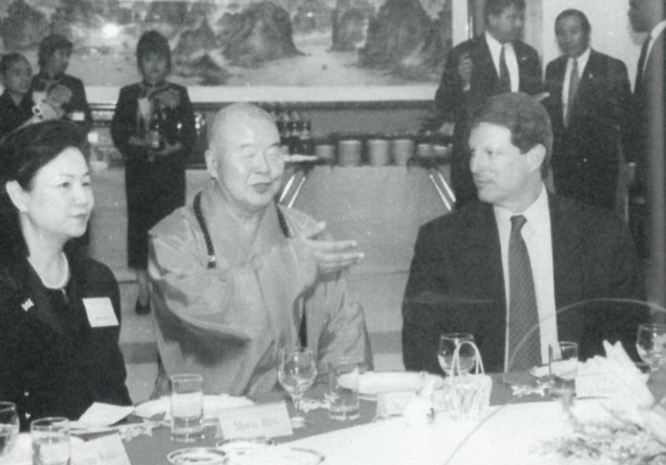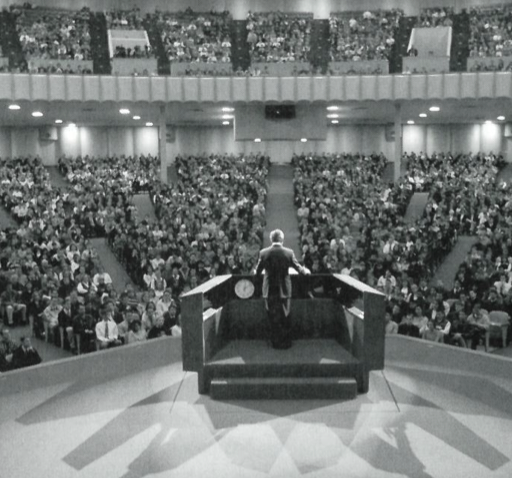
By now, the Hsi Lai Temple in suburban Los Angeles must be the best-known Buddhist institution in the United States. But it may be headed for an even higher profile.
Last winter, while Senator Bill Bradley unsuccessfully sought the Democratic presidential nomination, he brought up Hsi Lai Temple to raise questions about the integrity of Vice President Al Gore. Republican officials have strongly hinted that the temple will be mentioned again, in a new effort to embarrass Mr. Gore come this fall’s presidential campaign.
The reason for all the attention, of course, is that the fifteen-acre temple complex served as the site of a 1996 luncheon attended by the vice president, at which one of Mr. Gore’s fund-raisers arranged for contributions to be made to the Democratic National Committee in a manner that violated campaign finance laws.
As that scandal has been aired in political circles and newsmedia reports since then, Hsi Lai has usually been described simply as “the Buddhist temple,” as if there were only one.
If that seems to carry an unsettling negative tone, then it may be because these references run counter to the very good public reputation that Buddhists and Buddhist institutions have enjoyed in the United States, especially in recent years.
The question is, has Hsi Lai suffered the misfortune of becoming caught in a nasty political crossfire that’s going to run as long as Al Gore seeks the presidency?
Or are other issues being played out—a discomfort with monasticism, an indirectly expressed hostility to China, or perhaps even a backlash against the broad world of American Buddhism?
To put Hsi Lai in some context, the temple is by no means an institution unto itself nor do its teachings fall outside the major traditions.
Hsi Lai functions as the American center for a Chinese Mahayana Buddhist movement, Fo Guang Shan, begun in Taiwan thirty-three years ago and since expanded worldwide, with temples on six continents, universities, libraries, and major publishing operations. The movement’s founder is Master Hsing Yun, a native of mainland China and a Taiwanese resident since the Communist Revolution of 1949.
His followers at Hsi Lai say his influence is enhanced by his ability to teach the dharma in an appealingly down-to-earth way, applying Buddhist principles to everyday concerns.
One American academic who has spent considerable time studying Fo Guang Shan says it is well within the mainstream of Chinese Buddhism, bringing together the Ch’an (Zen) and Pure Land traditions. “This is one of the two largest Buddhist organizations in Taiwan, and has the largest monastic community of any Chinese Buddhist organization,” said Stuart Chandler, whose doctoral dissertation at Harvard University focused on Fo Guang Shan. The movement, he said, is well respected in Taiwan.
A magazine-sized description of the movement, titled “Our Report,” shows that Fo Guang Shan has not been shy about meeting with famous figures. It contains photographs of Master Hsing Yun with such notables as the Dalai Lama; the Russian novelist Alexandr Solzhenitsyn; Roman Catholic Cardinal Francis Arinze, a high Vatican official; and, in a photo dated 1989, Mr. Gore, then a senator from Tennessee.
When plans for the temple were announced two decades ago, homeowners in Hacienda Heights, a middle-class suburb on the northern flank of the Puente Hills, declared themselves opposed to putting the complex adjacent to a residential neighborhood.
Chandler said members of Fo Guang Shan spent much time and energy working to persuade neighbors there was nothing cultlike about the organization. Since the temple has been up and running, neighbors have been regularly invited to community events, like Chinese New Year celebrations.
An atmosphere of accessibility does seem to prevail at the place. Near the main gate is a small visitors’ center, and bilingual signs identify various temple features, like one that stands in a small garden before a statue of Avalokiteshvara, Bodhisattva of Compassion. As if to illustrate the lingering controversy, a film clip of Mr. Gore, taken during his problematic visit and broadcast on news programs during the early primaries, shows him standing with a crowd of monks and nuns.

Richard Hughes Seager, associate professor of religious studies at Hamilton College in Clinton, New York, said he thought that some of the controversy over Hsi Lai had involved “a yellow-peril dimension.” When the story about the fund-raising scandal first broke, he said, he began following editorial cartoons on the subject. “It did evoke the Charlie Chan image, and some of the old stereotypes related to Asia,” said Dr. Seager, who is the author of Buddhism in America (Columbia University Press).
In the post-Cold War era, Americans—or at least their political leaders—have been of two minds about China, uncertain whether that nation should be engaged as a trading partner or shunned as undemocratic, a potential military competitor in east Asia and the Pacific.
But how can an antipathy to China taint Hsi Lai, which, after all, is tied to an organization based in Taiwan, and was founded by a monk who left China ahead of the Revolution? And as a Buddhist institution, should the temple not benefit in the public mind from an association with such prominent co-religionists as the Dalai Lama and Thich Nhat Hanh, who publicly stand at odds with the policies of Communist governments?
Interestingly, when Seager began research for his book, Buddhism in America, he planned to include a chapter on its religious opponents—the anti-Buddhists, so to speak. But he turned up little evidence of a backlash against Buddhism’s American presence. “I didn’t find anyone all that interesting,” he said. “I’m sure it’s there, but it just didn’t seem substantial enough for me to worry about it.”
That in itself may signal a major change under way in American society, as tolerance becomes increasingly regarded as a value in itself.
In an earlier era, new religious groups—whether begun by innovators or imported by immigrants—could face active hostility from the dominant, conservative Protestant culture. Public disdain (and worse) fell at times on such perceived outsiders as the Shakers, Mormons, even Roman Catholics.
But these days, said Hughes, “there’s no authoritative center to do the beating up on the periphery, the way there was in the nineteenth century.”
Indeed, smaller, newer groups seem to be comfortably public, more inclined to publicize their festivals and special events, inviting outsiders to come, see, and possibly even join them. Even in the lesser cities of the Bible Belt, one can find spiritual alternatives to church and synagogue in Muslim, Hindu, Buddhist, and Baha’i groups, not to mention among those further from the old mainstream, such as the Wiccans.
From that perspective, the Hsi Lai Temple lies on the more comfortable side of a great dividing point in American religious history, the sweeping reform of the nation’s immigration laws in 1965. That allowed big increases in immigration from Asia, Africa, and Latin America, an influx of newcomers who brought their religious traditions with them and made them obvious through building houses of worship in city, suburb, and countryside.
Martin Marty, the religious historian recently retired from the University of Chicago Divinity School, said that “astonishingly,” Americans seem to have accepted “the multireligious character of our society as it changed after” the immigration law reform.
Marty said he believed that had Democrats raised money illegally at a Presbyterian church, the controversy would have been the same. The temple’s Buddhist identity may have “sharpened” the focus on it, he said, but added that “we can hardly be seen as massively anti-Buddhist when we find the Dalai Lama the biggest draw on every campus he can get to.”
“I think,” Marty said, “this is more a simple battle about political advantage than a true expression of anti-Buddhist sentiment.”
Yet there are other ways to look at the Hsi Lai controversy. It can serve as an example in a contrarian argument that Americans are not entirely at ease with religious pluralism, or at least have set limits as to how tolerant they will be.
Consider, for example, that the debate over Mr. Gore and the temple has been only one of two controversies to arise in connection with a presidential candidate’s visit to a religious site.
Texas governor George W. Bush encountered escalating criticism after speaking at Bob Jones University in Greenville, South Carolina, last February, without his having taken the time to repudiate that institution’s theological attacks on the Catholic Church, as well as its policy against interracial dating. The religious aspect of the issue so plagued Mr. Bush that he eventually felt compelled to write to the late Cardinal John O’Connor of New York, declaring that he rejected negative characterizations of Catholicism like those at Bob Jones.
Granted, there are vast differences between Bob Jones and Hsi Lai, but one similarity is that neither fits within the common definition of the American religious mainstream—mainline Protestants, Catholics, and Jews—that prevailed until the 1960s and that may possibly linger still. In that paradigm, both fundamentalism and immigrant Buddhism are on the outside.
The question remains whether many Americans are still working on the idea of pluralism, wrestling with what it means to live in a diverse society.
But then again, maybe that is not really the issue here.
Instead, one could argue that the controversies over Hsi Lai and Bob Jones became so prominent because those incidents mixed religion with qualities that Americans do not think should be involved—intolerance of other faiths (Bob Jones) or political fund-raising (at Hsi Lai).
Another argument is possible, too, one from a very different position. That would simply be to say that the political focus on Hsi Lai actually represents a sort of backhanded acknowledgment that the United States is so religiously diverse that political appearances can take place at a Buddhist temple, provided no money changes hands.
What supports this argument is that various political candidates have been putting in appearances among Islamic groups and at mosques for several years without fallout.
At Hsi Lai itself, there is a reluctance to talk much about the political controversy—evidence, one would think, of a profound fatigue with the issue. In an interview, some of the nuns said they had more important things to do, specifically propagating the dharma.
Taking an upbeat tone, Venerable Man Yee, one prominent nun at the temple, said it is good when those unfamiliar with Hsi Lai come to see it themselves. She thinks, she said, that the temple has been getting more than one thousand visitors a month.
“We will take them around,” she said, and explain “the basic principles of Buddhism.
“As soon as they find out there is a traditional monastery in Hacienda Heights,” she said, “they usually use the trip to come here to learn something new.”
Thank you for subscribing to Tricycle! As a nonprofit, we depend on readers like you to keep Buddhist teachings and practices widely available.